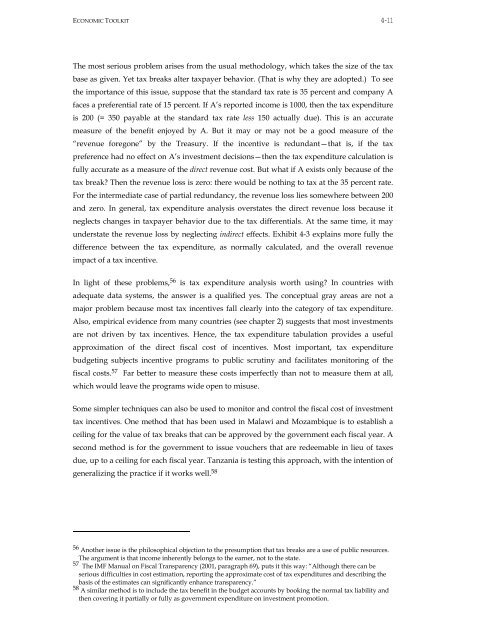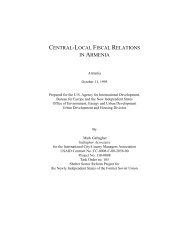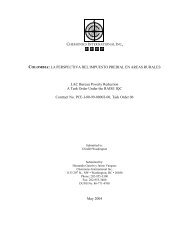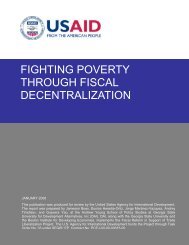Effectiveness and Economic Impact of Tax Incentives in the SADC ...
Effectiveness and Economic Impact of Tax Incentives in the SADC ...
Effectiveness and Economic Impact of Tax Incentives in the SADC ...
You also want an ePaper? Increase the reach of your titles
YUMPU automatically turns print PDFs into web optimized ePapers that Google loves.
ECONOMIC TOOLKIT 4-11<br />
The most serious problem arises from <strong>the</strong> usual methodology, which takes <strong>the</strong> size <strong>of</strong> <strong>the</strong> tax<br />
base as given. Yet tax breaks alter taxpayer behavior. (That is why <strong>the</strong>y are adopted.) To see<br />
<strong>the</strong> importance <strong>of</strong> this issue, suppose that <strong>the</strong> st<strong>and</strong>ard tax rate is 35 percent <strong>and</strong> company A<br />
faces a preferential rate <strong>of</strong> 15 percent. If A’s reported <strong>in</strong>come is 1000, <strong>the</strong>n <strong>the</strong> tax expenditure<br />
is 200 (= 350 payable at <strong>the</strong> st<strong>and</strong>ard tax rate less 150 actually due). This is an accurate<br />
measure <strong>of</strong> <strong>the</strong> benefit enjoyed by A. But it may or may not be a good measure <strong>of</strong> <strong>the</strong><br />
“revenue foregone” by <strong>the</strong> Treasury. If <strong>the</strong> <strong>in</strong>centive is redundant—that is, if <strong>the</strong> tax<br />
preference had no effect on A’s <strong>in</strong>vestment decisions—<strong>the</strong>n <strong>the</strong> tax expenditure calculation is<br />
fully accurate as a measure <strong>of</strong> <strong>the</strong> direct revenue cost. But what if A exists only because <strong>of</strong> <strong>the</strong><br />
tax break? Then <strong>the</strong> revenue loss is zero: <strong>the</strong>re would be noth<strong>in</strong>g to tax at <strong>the</strong> 35 percent rate.<br />
For <strong>the</strong> <strong>in</strong>termediate case <strong>of</strong> partial redundancy, <strong>the</strong> revenue loss lies somewhere between 200<br />
<strong>and</strong> zero. In general, tax expenditure analysis overstates <strong>the</strong> direct revenue loss because it<br />
neglects changes <strong>in</strong> taxpayer behavior due to <strong>the</strong> tax differentials. At <strong>the</strong> same time, it may<br />
understate <strong>the</strong> revenue loss by neglect<strong>in</strong>g <strong>in</strong>direct effects. Exhibit 4-3 expla<strong>in</strong>s more fully <strong>the</strong><br />
difference between <strong>the</strong> tax expenditure, as normally calculated, <strong>and</strong> <strong>the</strong> overall revenue<br />
impact <strong>of</strong> a tax <strong>in</strong>centive.<br />
In light <strong>of</strong> <strong>the</strong>se problems, 56 is tax expenditure analysis worth us<strong>in</strong>g? In countries with<br />
adequate data systems, <strong>the</strong> answer is a qualified yes. The conceptual gray areas are not a<br />
major problem because most tax <strong>in</strong>centives fall clearly <strong>in</strong>to <strong>the</strong> category <strong>of</strong> tax expenditure.<br />
Also, empirical evidence from many countries (see chapter 2) suggests that most <strong>in</strong>vestments<br />
are not driven by tax <strong>in</strong>centives. Hence, <strong>the</strong> tax expenditure tabulation provides a useful<br />
approximation <strong>of</strong> <strong>the</strong> direct fiscal cost <strong>of</strong> <strong>in</strong>centives. Most important, tax expenditure<br />
budget<strong>in</strong>g subjects <strong>in</strong>centive programs to public scrut<strong>in</strong>y <strong>and</strong> facilitates monitor<strong>in</strong>g <strong>of</strong> <strong>the</strong><br />
fiscal costs. 57 Far better to measure <strong>the</strong>se costs imperfectly than not to measure <strong>the</strong>m at all,<br />
which would leave <strong>the</strong> programs wide open to misuse.<br />
Some simpler techniques can also be used to monitor <strong>and</strong> control <strong>the</strong> fiscal cost <strong>of</strong> <strong>in</strong>vestment<br />
tax <strong>in</strong>centives. One method that has been used <strong>in</strong> Malawi <strong>and</strong> Mozambique is to establish a<br />
ceil<strong>in</strong>g for <strong>the</strong> value <strong>of</strong> tax breaks that can be approved by <strong>the</strong> government each fiscal year. A<br />
second method is for <strong>the</strong> government to issue vouchers that are redeemable <strong>in</strong> lieu <strong>of</strong> taxes<br />
due, up to a ceil<strong>in</strong>g for each fiscal year. Tanzania is test<strong>in</strong>g this approach, with <strong>the</strong> <strong>in</strong>tention <strong>of</strong><br />
generaliz<strong>in</strong>g <strong>the</strong> practice if it works well. 58<br />
56 Ano<strong>the</strong>r issue is <strong>the</strong> philosophical objection to <strong>the</strong> presumption that tax breaks are a use <strong>of</strong> public resources.<br />
The argument is that <strong>in</strong>come <strong>in</strong>herently belongs to <strong>the</strong> earner, not to <strong>the</strong> state.<br />
57 The IMF Manual on Fiscal Transparency (2001, paragraph 69), puts it this way: “Although <strong>the</strong>re can be<br />
serious difficulties <strong>in</strong> cost estimation, report<strong>in</strong>g <strong>the</strong> approximate cost <strong>of</strong> tax expenditures <strong>and</strong> describ<strong>in</strong>g <strong>the</strong><br />
basis <strong>of</strong> <strong>the</strong> estimates can significantly enhance transparency.”<br />
58 A similar method is to <strong>in</strong>clude <strong>the</strong> tax benefit <strong>in</strong> <strong>the</strong> budget accounts by book<strong>in</strong>g <strong>the</strong> normal tax liability <strong>and</strong><br />
<strong>the</strong>n cover<strong>in</strong>g it partially or fully as government expenditure on <strong>in</strong>vestment promotion.











